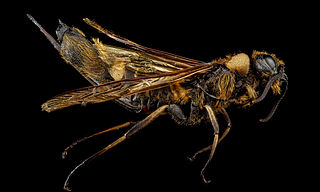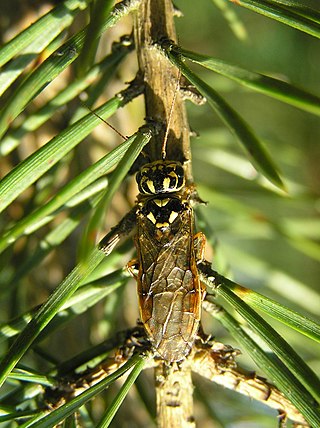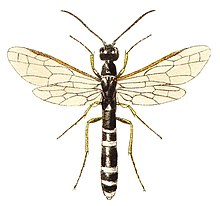
Sawflies are wasp-like insects that are in the suborder Symphyta within the order Hymenoptera, alongside ants, bees, and wasps. The common name comes from the saw-like appearance of the ovipositor, which the females use to cut into the plants where they lay their eggs. The name is associated especially with the Tenthredinoidea, by far the largest superfamily in the suborder, with about 7,000 known species; in the entire suborder, there are 8,000 described species in more than 800 genera. Symphyta is paraphyletic, consisting of several basal groups within the order Hymenoptera, each one rooted inside the previous group, ending with the Apocrita which are not sawflies.

Horntail or wood wasp are any of the 150 non-social species of the hymenopteran family Siricidae, a type of wood-eating sawfly. The common name "horntail" derives from the stout, spine-like structure at the end of the adult's abdomen, which is used to pierce the host's bark to allow the eggs to be inserted into the wood. A typical adult horntail is brown, blue, or black with yellow or red parts, and may often reach up to 4 cm (1.6 in) long. The pigeon horntail can grow up to 5 cm (2.0 in) long, among the longest of all Hymenoptera.

Alexandr Pavlovich Rasnitsyn is a Russian entomologist, expert in palaeoentomology, and Honored Scientist of the Russian Federation (2001). His scientific interests are centered on the palaeontology, phylogeny, and taxonomy of hymenopteran insects and insects in general. He has also studied broader biological problems such as evolutionary theory, the principles of phylogenetics, taxonomy, nomenclature, and palaeoecology. He has published over 300 articles and books in several languages. In August 2008 he was awarded the Distinguished Research Medal of the International Society of Hymenopterists.

The Orussidae or the parasitic wood wasps represent a small family of sawflies ("Symphyta"). Currently, about 93 extant and four fossil species are known. They take a key position in phylogenetic analyses of Hymenoptera, because they form the sister taxon of the megadiverse apocritan wasps, and the common ancestor of Orussidae + Apocrita evolved parasitism for the first time in course of the evolution of the Hymenoptera. They are also the only sawflies with carnivorous larvae.

Anaxyelidae is a family of incense cedar wood wasps in the order Hymenoptera. It contains only one living genus, Syntexis, which has only a single species, native to Western North America. Fossils of the family extend back to the Middle Jurassic, belonging to over a dozen extinct genera, with a particularly high diversity during the Early Cretaceous. Syntexis lay eggs in the sapwood of conifers, preferring recently burnt wood.

The Xyelidae are a comparatively species-poor family of sawflies, comprising about 80 extant species in five genera worldwide, and is the only family in the superfamily Xyeloidea. The fossil record of the family is extensive, comprising more than 120 species and including the oldest fossil Hymenoptera species dating back to the Triassic, between 245 and 208 million years ago. Xyelidae are to be regarded as living fossils since they represent one of the oldest lineages of insects and include still extant forms.

The Pamphilioidea are a small superfamily within the Symphyta, containing some 250 living species restricted to the temperate regions of Eurasia and North America. These hymenopterans share the distinctive feature of a very large, almost prognathous head, which is widest ventrally.

The Megalodontesidae are a small family of sawflies, containing a single living genus, Megalodontes, with some 40 species restricted to the temperate regions of Eurasia. Larvae of Megalodontesidae feed on herbaceous plants. They are distinguished from the closely related Pamphiliidae by their serrate or pectinate antennae.

Pamphiliidae is a small wasp family within Symphyta, containing some 200 species from the temperate regions of North America and Eurasia. The larvae feed on plants, using silk to build webs or tents, or to roll leaves into tubes in which they feed, thus earning them the common names leaf-rolling sawflies or web-spinning sawflies. Some species are gregarious and the larvae live in large groups. Fossils of Pamphiliidae have been dated to the Jurassic period.

Tenthredinidae is the largest family of sawflies, with well over 7,500 species worldwide, divided into 430 genera. Larvae are herbivores and typically feed on the foliage of trees and shrubs, with occasional exceptions that are leaf miners, stem borers, or gall makers. The larvae of externally feeding species resemble small caterpillars. As with all hymenopterans, common sawflies undergo complete metamorphosis.

Trigonalidae is one of the more unusual families of hymenopteran insects, of indeterminate affinity within the suborder Apocrita, and presently placed in a unique superfamily, Trigonaloidea, and the only extant taxon in the superfamily. The other putative related taxon is the extinct family Maimetshidae, known from the Cretaceous period. Trigonalidae are divided into 2 subfamilies; Orthogonalinae and Trigonalinae. These wasps are extremely rare, but surprisingly diverse, with over 90 species in 16 genera, and are known from all parts of the world. It is possibly the sister group to all Aculeata.

Nematinae is a subfamily of sawflies belonging to the family Tenthredinidae. It contains over 1250 described species in ~40 genera. Members of this subfamily feed on a wide range of plants and employ a wide range of feeding habits, both internally and externally, on their host plants.

Allantinae is a subfamily of sawflies in the family Tenthredinidae, and the largest subfamily of that family, with about 110 genera. The subfamily is considered to consist of five to six tribes, and are medium to large sawflies.
Sepulcidae is an extinct family of stem sawflies in the order Hymenoptera. The family is known primarily from late Mesozoic fossils found in 1968 in Transbaikalia. The insects were distant relatives of modern sawflies and are part of the living superfamily Cephoidea.

Cephidae is a family of stem sawflies in the order Hymenoptera. There are about 27 genera and more than 160 described species in Cephidae.

Monostegia is a genus of sawfly. The authority is based on the description by Achille Costa and Oronzio Costa, although earlier work grants this to Fabricius 1798., though the most common species, M. abdominalis, bears the authority of Fabricius.
Cuspilongus is an extinct genus of symphytan wasps in the sawfly family Cephidae and the only genus in the subfamily Cuspilonginae. At the time of its description, the genus comprised a single species, Cuspilongus cachecreekensis. A second species, Cuspilongus ghilarovi, was transferred from Mesocephus, which it had been ascribed to at the time of description in 1988. The genus is known from fossils found in the Early Cretaceous of Mongolia and Early Eocene of Canada.
Karatavitidae is an extinct family of sawflies, known from the Jurassic period, they are the only members of the superfamily Karatavitoidea. While once proposed to be grouped with the Orussoidea in the infraorder Orussomorpha, they are now considered to be the closest relatives of clade containing Orussoidea and Apocrita. There are about 7 genera in Karatavitidae.
Sepulca is an extinct genus of stem sawflies in the family Sepulcidae.
Prosyntexis is an extinct genus of stem sawflies in the family Sepulcidae. There are at least four described species in Prosyntexis.















